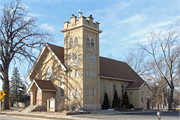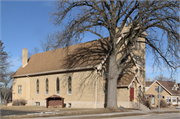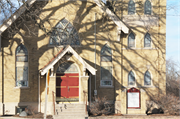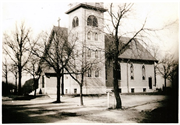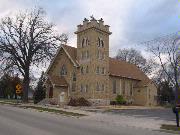| Additional Information: | DESCRPTION
This church building is constructed of cream brick and decorated in Gothic Revival style. The church has a steeply-pitched gable-roof. On the front facade there is a row of brick corbelling under the eaves, a gothic arch stained glass window and some smaller gothic arched windows. An enclosed entryway extends from the church entrance. The side of the church has symmetrically places gothic-arched stained glass windows. The bell tower is square and features sets of gothic arched stained glass windows. Round arches accent a pair of louvered gothic arches. Above this is a prominant cornice. Above the cornice are battlements.
HISTORICAL BACKGROUND
St. John's Evangelical Lutheran Church dates back to 1848 when land was purchased for a church building for this congregation. The first church building was a log structure and 1881 the congregation built a stone church to serve its growing congergation. In 1925, again needing additional spaces, the congreagatrion attempted to add to the existing building, but the old church collapsed under the remodeling project. In August of 1925 the cornerstone for this church was laid. The $20,000 building was dedicated in January of 1926 and both German and English services were conducted in the new building. In 1970 the congregation has 400 members and their school taught 38 pupils. [g, "St. John's Evangelical Lutheran Church"]
RESURVYED 2023 by HRL/Vogel:
Architectural Description:
The gabled, Gothic Revival church was constructed in 1925 and rises from a concrete foundation that extends above ground and terminates at the water table. Thereafter is the structure constructed of cream brick laid in a running bond. With a few exceptions, the Gothic windows are tall, narrow and topped with pointed arches framed by horizontally/vertically laid brick stretchers and two courses of slightly projecting, vertically/horizontally laid brick headers. All arched windows are embellished with a prominent keystone as well as a concrete sill.
The church’s main entrance is centered in the primary façade, which is the south gabled endwall. Six concrete steps lead to a small vestibule, the double doors to which are framed by brick columns crowned with concrete caps from which springs a Romanesque arch constructed of brick stretchers and crowned by a prominent keystone. Two brackets are also supported by the concrete caps and help to support the small, gabled roof over the vestibule, to the east (right) and west (left) of which are tall, narrow, lancet windows. Above and centered on the vestibule is an arched Gothic window with tracery. Immediately to the right (east), in the church’s southeast corner, is a four story bell tower, the first three levels of which are defined by paired, lancet windows with a continuous concrete sill on the tower’s south and east sides. The fourth level, on its west, south and east sides, is defined by a prominent Romanesque arch in which is set two, louvered Gothic arches. A cornice from which rises a crenelated parapet crowns the bell tower. The west and east sidewalls of the church are generally defined by four, symmetrically placed, Gothic windows. The building was enlarged and extended to the north by 21 feet, likely sometime in the 1970s as suggested by an analysis of aerial photographs. The addition included a single, paired, double-hung window opening on its west side in addition to another entrance vestibule on its east side. Embellished with two, small circular windows and one, double hung window, the vestibule claims one door off-set to the right (north) of its east-facing endwall that is sheltered by a nominally-pitched, shed roof supported by brackets.
|
|---|
| Bibliographic References: | [a] Plat Maps for the city of Mequon, 1867-1980, on file at the Mequon Historical Society, Mequon, Wisconsin, or the Archives at the State Historical Society, Madison, Wisconsin.
[b] Tax Rolls for the city of Mequon, 1857-1930, on file at the library, Mequon, Wisconsin.
[c] Field observation based on architectural and historical information.
[d] Information from the owner of the property.
[e] Information from the building's datestone or inscription.
[f] Freistadt Historical Society, Freistadt and the Lutheran Immigration, Mequon: Trinity Evangelical Lutheran Church, 1989.
[g] L. Rehm, Mequon History, on file at the Mequon Historical Society, Mequon, Wisconsin.
[h] C.W. Butterfield, History of Washington and Ozaukee Counties, Chicago: Western Publishing Company, 1880.
[i] Information from the Mequon Landmarks Commission, Mequon, Wisconsin. |
|---|

